Insects in Italy
Everything you need to know to stop worrying :)
Worried a bit about poisonous insects in Italy and the hairy eight-legged ones? Don't be. This lovely lady and her beetle, bug and butterfly friends are the most scary things you are likely to see :)
The Old World swallowtail butterfly (Papilio machaon) - "il macaone" - she wouldn't sit still long enough for me to take a photograph, so I captured her on video instead feeding in June on these pink wildflowers growing out of a rock in the wonderful hill town of Roccalbegna in Maremma.
Note: click on the HD option for the video - bottom right tag - to see her best in her full glory :)
The wonderful world of insects in Italy
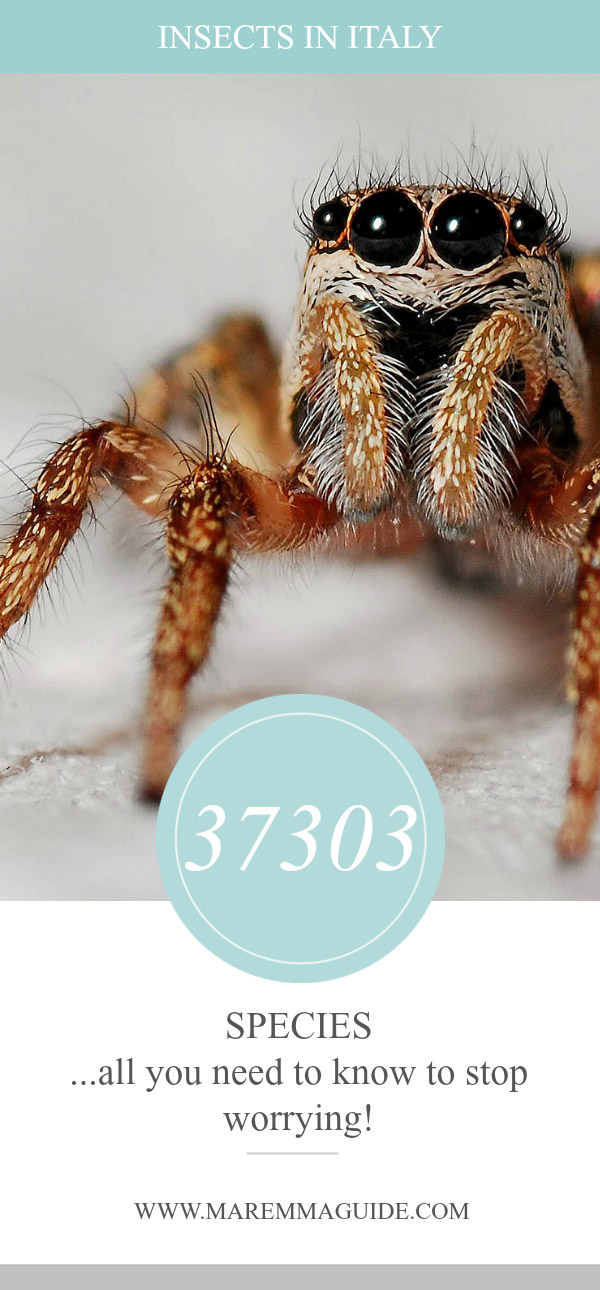
Italy is the richest country in the world as far as insect species go with, at last count, 37303 different species living in the varied habitats that its geography, geology and climate provide. That number represents a massive ninety-eight percent of all Italian fauna.
So, if wrote about them all, this page could go on forever. Instead, I am going to show you the ones that I have come across frequently in over a decade of living in Tuscany and tell you about a couple you probably won't ever see. Which are the ones you are probably worried about.
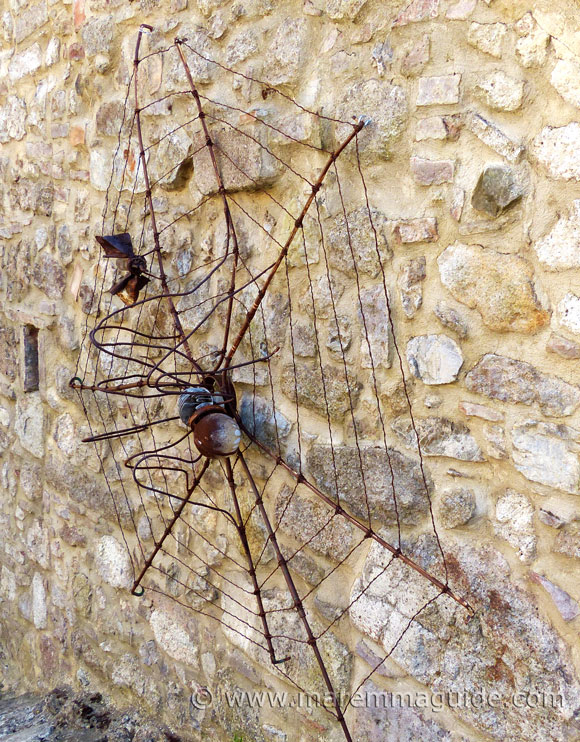 A fly caught in the trap of a long-legged spider in Roccatederighi in Maremma!
A fly caught in the trap of a long-legged spider in Roccatederighi in Maremma!
Common insects in Tuscany Italy
The list of insects in Tuscany that you will likely see, and/or hear, include:
- the ant - "la formica"
- the butterfly - "la farfalla"
- the tree cricket cicada - "la cicala" - which you will hear more than likely see.
- the cricket - "il grillo"
- the firefly - Lampyris noctiluca - "la luciola" - turn a garden into a magical fairyland that will have your kids chasing around to catch one when it gets dark :)
- the fly - "la mosca"
- the grasshopper - "la cavalletta"
- the ladybird - "la coccinella"
- the millipede - "il millepiedi"
- the ambush predator, but oh so captivating when you spot one in your garden, preying mantis - "la mantide religiosa"
- the wasp - "la vespa"
Together with...
The firebug
The red and black firebug - "la cimice rossonera" (Pyrrhocoris apterus). I only ever normally get to see one of these at a time, sat on the centre of a flower.
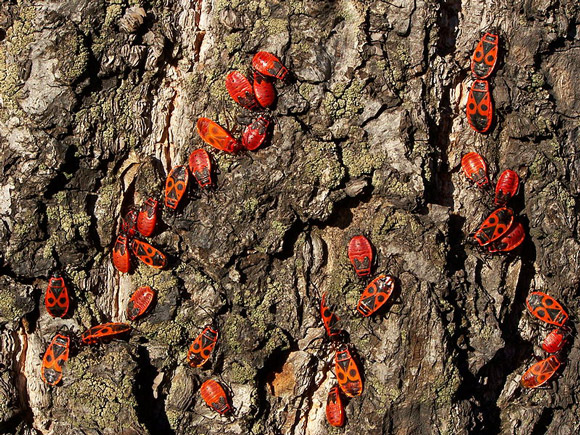 The red and black firebug - cimicie rossonera - photo by Jan Mehlich
The red and black firebug - cimicie rossonera - photo by Jan Mehlich
Giant black bees in Italy - l'ape
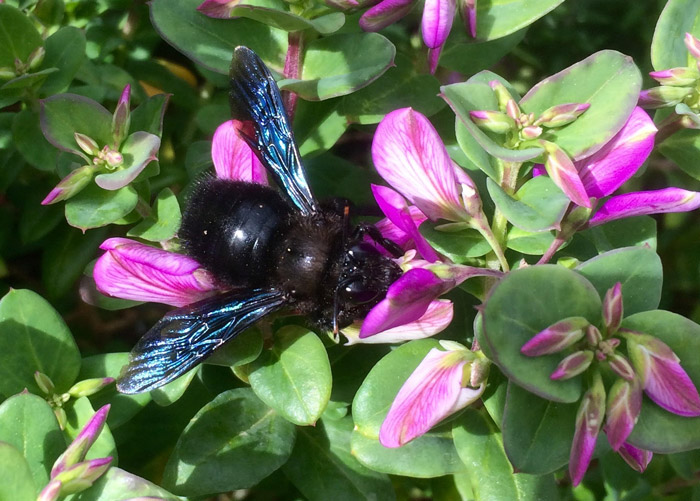 Photo by Cisamarc.
Photo by Cisamarc.
Of all of Tuscany's bees, it is the magnificent and huge black one called the Xylocopa violacea - the violet carpenter bee - that you are less likely to see but most likely to remember, because it is so big and black and noisy in flight. Just duck out of it's way when it passes by. They aren't usually aggressive and we have them in our garden from time to time in the spring and I have never been stung.
Bees in Italian is "Api". And just one bee is "Ape".
Hornets in Italy - the European hornet - Il calabrone
The violet carpenter bee is often mistakenly called a "calabrone", but it isn't. "Calabroni" are huge too - the biggest in Europe reaching up to 4 cm long - but they are a wasp, the European hornet.
"Vespa crabro" in Italian.
Generally striped black and yellow, not totally black. You don't want to get stung by one of these, so the duck and let it continue on its way advice still holds true. To be honest, I don't recall having seen more than one in more than a decade.
Sometimes you might hear the big bumble bee - the Bombus terrestris - being called a calabrone too, but it isn't. Generally speaking, any huge bee/wasp looking thing is called a "calabrone" by my Italian relatives and friends!
The beetle - il coleottero
In this case, the wonderfully iridescent green coloured Rose chafer - "la cetonia dorata" - Cetonia aurata. Isn't he splendid.
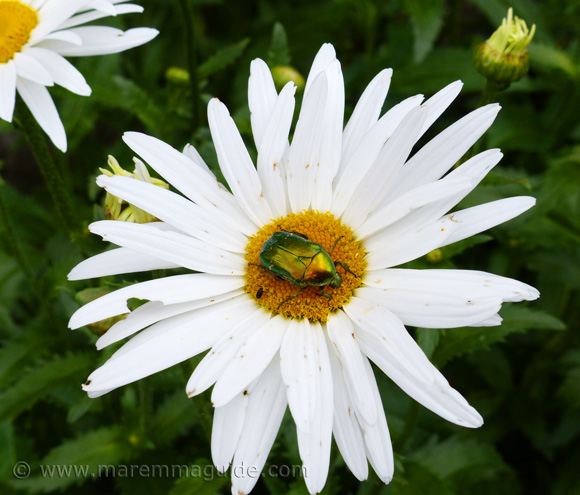 Coleoptera in Tuscany: the Green Rose chafer.
Coleoptera in Tuscany: the Green Rose chafer.
The moths - le falene
The stately nocturnal Oak Hawk-moth - "la sfinge del leccio" - Marumba quercus.
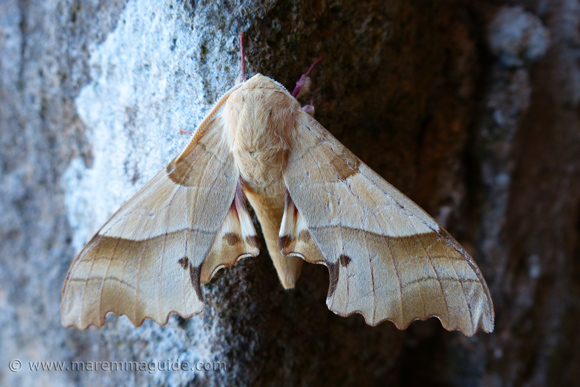
And the incredible Hummingbird hawk-moth - "la sfinge del galio" - Macroglossum stellatarum.
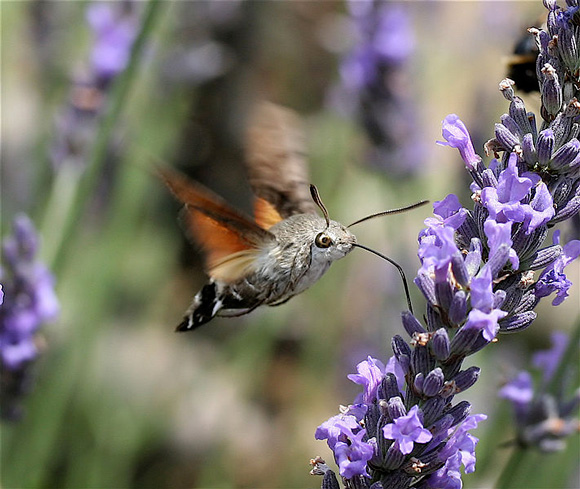
The dragonfly - la libellula
The darter and skimmer dragonflies - "le libellule". These were catching some sun in the dunes of the Parco Costiero della Sterpaia on a warm late October afternoon.
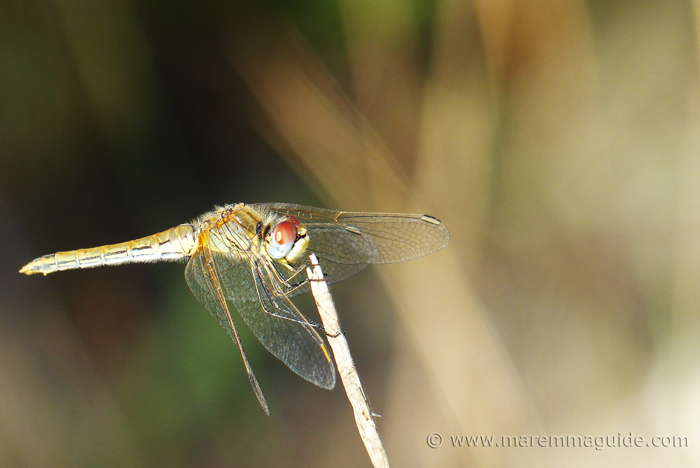
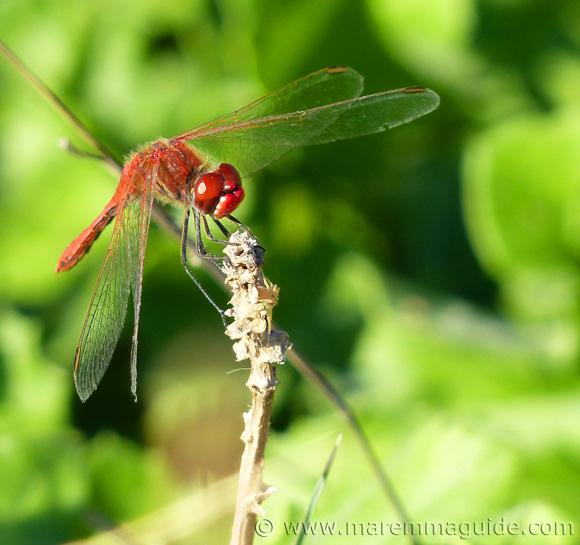 The scarlet darter dragonfly - Crocothemis erythraea
The scarlet darter dragonfly - Crocothemis erythraeaDragonflies love Italy, for in the whole of the Mediterranean, it is here that their species number the most: at last count, 93 species. But, and it is also true - and for which scientific studies in collaboration with the WWF are underway here - that nearly 11 percent of those are close to extinction.
And these large blue ones - more than fifty of them - gave us a truly magical end to what was already a very beautiful late September afternoon on Le Marze beach near Castiglione della Pescaia. For just as the sunlight was waning and the mosquitoes were starting to bite on the beach, we started walking along the access lane through the "pineta" (pine wood) behind the dunes to our car, and there they were at head height and above, feeding on the mosquitoes that had been feeding on me.
NOTE. The video is very short and I didn't manage to catch any close-up - they were too busy having dinner to take a rest! - but I hope, nonetheless, that it gives you an idea of the magic that was in the air that night :)
The Damselflies - le damigelle
These two are the Large red damselfly: one of the first damselflies to emerge in the spring sunshine.
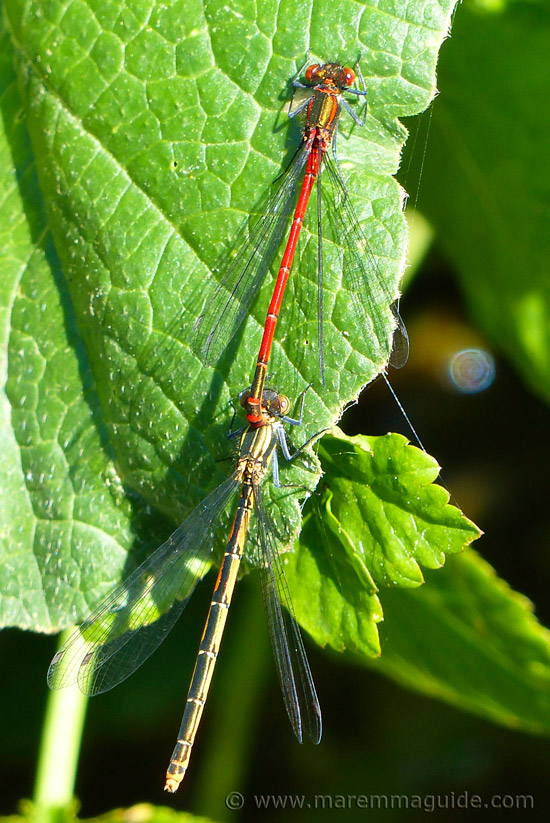 Pyrrhosoma nymphula
Pyrrhosoma nymphula
Well, for those of you who were worried about what horrible insects you might find during your holiday here in Tuscany, that wasn't too bad now was it?
Now, however, for one that is the bane of my life and will probably have you blaspheming.
The mosquito in Italy
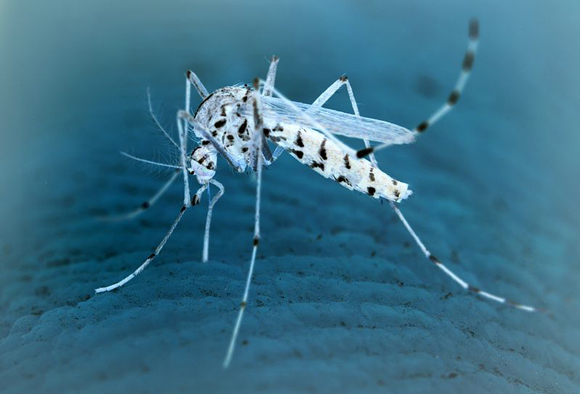 The tiger mosquito - the "zanzara tigre" in Italian.
The tiger mosquito - the "zanzara tigre" in Italian.
This insect is the one that most of the time you will know has visited after your encounter - that is after he has fed on you!
The mosquito - "la zanzara" in Italian.
The image above is a negative - his colour is brown (you can see him as he is in real life by clicking on the link above) - as I wanted you to see the stripes from which he gets his name. But you won't need a macro lens to see them in real life.
The tiger mosquito is bigger than Italy's indigenous mosquito and you'll easily catch a glimpse of his long, long stripy legs as he buzzes around you.
He deserves a page all to himself and not because I like him! Mosquitoes in Tuscany Italy.
And one that might make you scream.
But which I deliberately haven't included in the details of the poisonous insects in Italy. Because even he.
Frighteningly looking.
Or not.
Isn't poisonous.
Scorpions in Italy
Are there scorpions in Tuscany? Yes, there are. But they are small and would rather not, no offence meant, meet you!
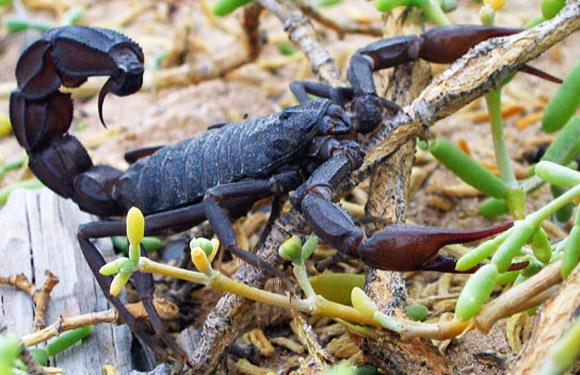
The scorpions in Italy you are unlikely to see.
The poisonous insects in Italy
Are there any poisonous insects in Italy? No. There are no indigenous insects in Italy that are considered to be life threatening to man. So sleep easy.
But, just as in other parts of the world, bee and wasp stings, spider bites etc can induce allergic or anaphylactic reactions in some people, the severity of which in some cases can result in death. Your biggest risk in Italy - the same as it is in other countries - is from simultaneous multiple stings and bites. The affect of thirty or so bee or calabrone stings will be no different here than it is back home.
And, of course, children, the elderly, or those who are weak through illness etc, should always take particular care as the effect of toxins is much greater on their bodies.
But there is a moth I want to tell you about.
Processionaria del pino - Pine processionary
It is the Pine processionary moth - "Processionaria del pino" in Italian - or rather, its caterpillar that you need to know about.
For, although if you see them coming down a tree trunk whilst out in the woods or enjoying some shade in a pineta behind a Maremma beach, you will probably run for your camera as their procession is very photogenic, instead you should run in the opposite direction. OK, that was over alarmist! Take the photo :)
But don't be tempted to touch them, let your children touch them, or let your dog, or horse, near one.
Better still, change location too, because it is the hairs of these caterpillars that are the problem and they can be found on and around an infected tree and its leaves.
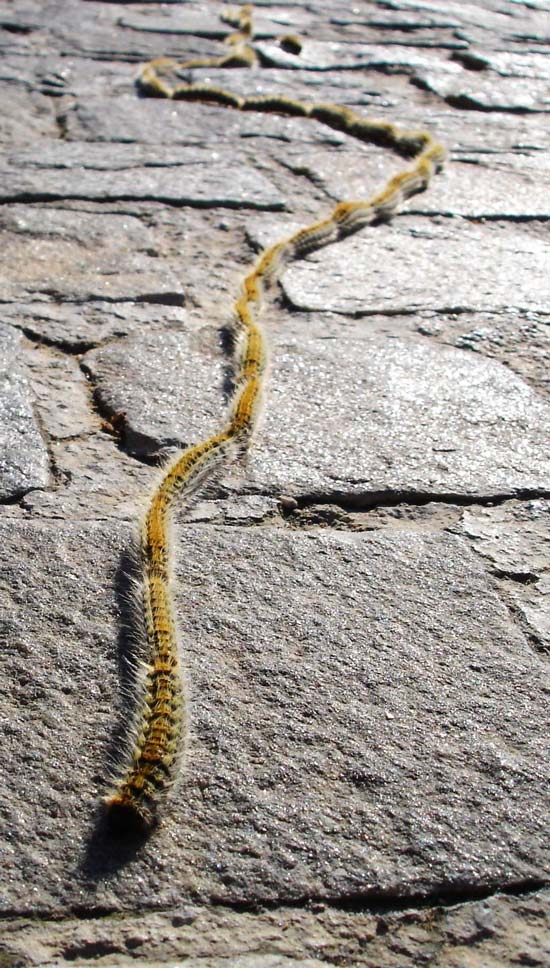 The hairy caterpillars of the Pine processionary moth Thaumetopoea pityocampa
The hairy caterpillars of the Pine processionary moth Thaumetopoea pityocampaThe harpoon hairs that cover its upper body and end are urticating hairs: they release a protein poison that causes extreme skin irritation - hives - and can cause a severe allergic reaction in some people.
But it doesn't stop there. The older the caterpillars are, the more highly urticating and so dangerous they become, until in their final stage they can actually eject their hairs in defense.
If infected fingers touch eyes or mouths, they in turn will become severely irritated.
The pine processionary moth's preferred habitats are pine woods - which you will find behind most of Maremma's beaches - and deciduous oak woods. Their nests at the top of branches look like huge white tents of spider web.
But that isn't to say that you, or more likely, your dog won't. And it is for your dog that I am calling this moth out for special attention. He won't be able to stop himself licking his wounds and these hairs can lead to necrosis of the tongue and, when ingested, renal failure. Seeking veterinary assistance is essential.
But before you go off telling your partner that you're not sure anymore about a beach trip or a walk in the woods in Maremma, I want to tell you that I have never seen one. And I go walking and exploring a lot and spend at least one or two afternoons a week at the beach, time that always includes walks in the "pineta" taking photographs.
A couple more insects that you more than likely will never meet and won't want to are in this page.
Spiders in Italy
Worried about meeting spiders as big as these whilst you are here? Well, don't. I'll tell you why.
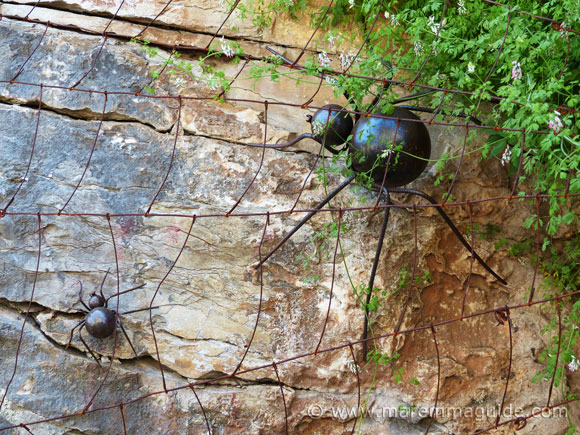
"I ragni in Italia" - spiders in Italy.
Explore some more...


















